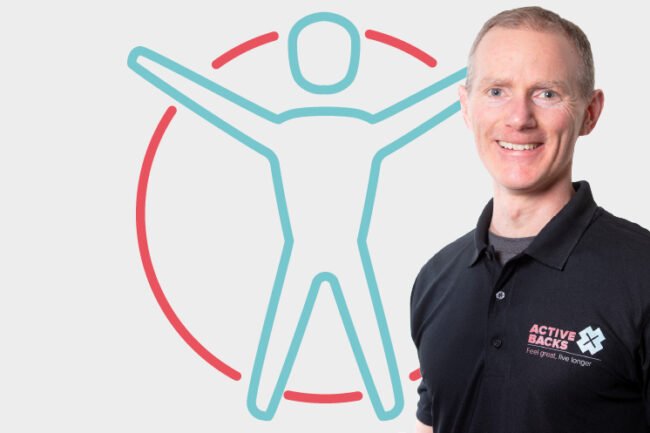How to walk with low back pain / sciatica?
How to walk with low back pain / sciatica?
Today’s episode is entitled “How to walk with low back pain / sciatica?” You will learn:
- Revisiting the “Use it but don’t abuse it” rule
- The value of walking
- When to use a stick to walk with low back pain / sciatica
- Is it OK to stoop or not
- The power of bracing (when you walk with low back pain / sciatica)

Revisiting the “Use it, but don’t abuse it” rule
It’s vitally important that you stay as active and mobile as you possibly can within the limits of pain. If you do things that increase your pain, you will potentially be doing one of two things or both. If you do things that hurt, you could be preventing healing from taking place. And you could also be further sensitizing the pain pathways and increasing the likelihood that you end up with chronic pain or a long lasting pain. It’s equally important that you remain active. So try and just follow normal life with the odd adaptation, and the more movement you do, the better.
The value of walking
Humans evolved walking. We traveled over large distances frequently, always on foot. I’m talking here for most of human evolution. We did a lot of walking, and we’re very good at it. We’re well adapted for walking and our lower backs like walking. So for the vast majority of my patients, I encourage them to do more walking, because it’s good for their backs. As you walk along, your lower back is bending side to side and essentially motion is lotion. So by moving, you’re increasing the blood flow. You’re washing away any inflammation that’s there. It’s just good for your back.
Use it, but don’t abuse it. If walking a mile is beyond you, and it gets really sore after you’ve been doing it for 10 minutes, but you’re okay walking for five minutes, then do five minutes or seven minutes or eight minutes, but don’t go for the full 10. One approach to building up an activity again, when you’re recovering and rehabilitating from lower back pain / sciatica, is to build things gradually. Otherwise you end up in that boom and bust cycle. So if you know you can walk for 8 minutes without increasing your pain, then walk for 8 minutes. But do it two or three times a day, and that will be fine. Whereas if you try to walk a full 30 minutes and no wonder that could be a significant setback. No pain, no gain” has absolutely no place in rehabilitation.
When to use a stick to walk with low back pain / sciatica
It’s absolutely a good decision, as you are still able to stay reasonably mobile, to walk a couple of hundred yards. More importantly, you’re actually moving around, using the muscles and joints, keeping them lubricating, avoiding loss of muscle mass, which can happen very rapidly if you are inactive. Using a stick is a sane move if it enables you to stay active, if it’s too painful to walk and therefore you don’t walk at all.
But it’s only a good thing for as long as you really need to. Every once in a while, try without the stick. If you can walk 200 yards without it, but then you can walk 400 yards with a stick. You’re almost certainly better to do the 200 yards without the stick than the 400 yards with the stick. By using a stick you are compromising, putting loads on tissues, joints and muscles in a way that they’re not used to being loaded. The last thing you want is to develop a secondary problem, and these are often not terribly obvious at the time.
Because you have so much pain in your lower back / sciatica, you can only really experience that pain, but by compensating significantly, you could be causing a problem elsewhere. It’s not really sore at the time because your attention isn’t wholly on the very painful, lower back. But as the lower back recovers, you find the pain. Well, you’ve been leaning on a stick on that side much more, and your shoulders are just not used to it. So essentially you’ve now kind of injured your shoulder a little bit. There is a time and a place for a stick, but there’s also a time and a place for you to stop using the stick.
Is it okay to stoop or not
Frequently, people with severe lower back pain / sciatica will have a stoop, which is not typically something that you will be doing voluntarily. You just find that you can’t fully straighten up, you’re stooped forwards, and this is your body’s way of protecting you and moving you away from the painful position. People who are stooped forwards find it difficult to stand upright and very painful to arch backwards, so you shouldn’t be doing it. Use it but don’t abuse it. You’re just going to have to go with the stoop, but be conscious that you are stooping.
You are using bits of your body in ways that they’re not used to being used, and you may well start to get sore in other places. So there is any good clinician. If they see that you are stooping, we’ll provide you with what I would call prophylactic treatment. They’ll observe the stoop and they’ll work on you. To ensure, or to minimize the risks that you do get sore in other places. Good manual therapy and did therapy as a whole. Isn’t just about dealing with the immediate symptom. It’s about predicting what impact that’s having on the rest of the body undermined and mitigating against those factors. If you have a stoop, don’t try and force against the stoop, if it’s painful to do so.
Because of the stoop, you may well be causing streams and experiencing some pain and discomfort. Do something about that, treat that as a separate issue. Don’t allow it to progress and worsen. The last thing you need is a sore back, neck, shoulder, upper back and so on. It’s absolutely fine to stoop, particularly if that enables you to be a little bit more active. But don’t spend a lot of time in a stooped position because it may come at a price.
The power of bracing (when you walk with low back pain / sciatica)
Bracing can be very useful. When you’re trying to stand up, lightly brace your abdominal muscles. Think about a small child’s going to punch you in the stomach and you have to tense up. By tightening your abdominal muscles, they will wrap around into your lower back muscles and help to stabilize your lower back. Maybe that’s exactly what your back needs, and by doing so you don’t have to stoop as much, or you’re able to walk further without it increasing your pain.


